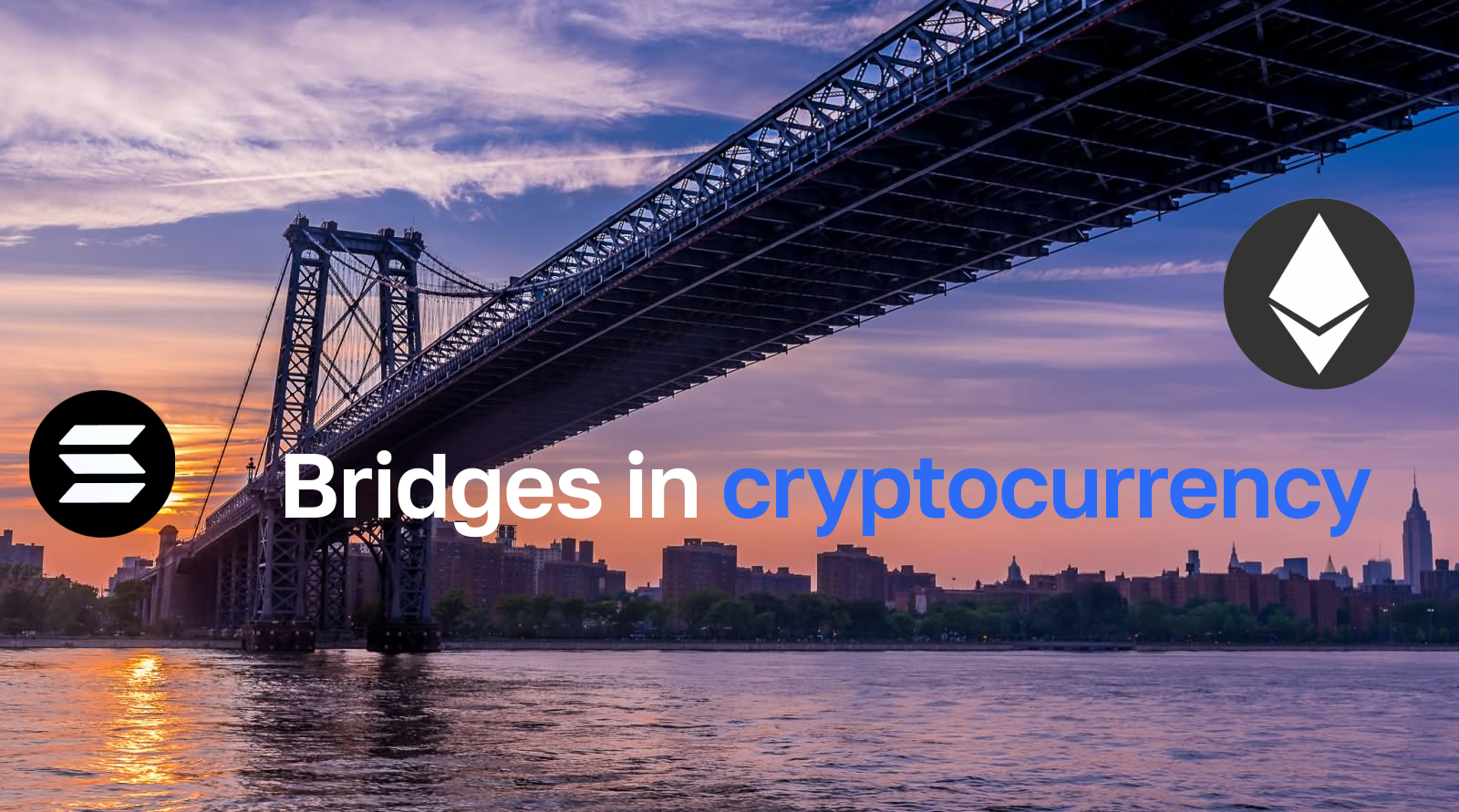Bridges in cryptocurrency, what are they? And how they work

Cryptocurrency Bridge (or simply Bridge)
A cryptocurrency bridge is a technology that enables the transfer of assets between different blockchains. Imagine a bridge as a means of connecting two independent blockchains, allowing users to move their digital assets from one blockchain to another while preserving their value and properties.
Why are bridges needed?
1. Compatibility: Bridges ensure interoperability between different blockchains, allowing users and developers to exchange assets and information between different ecosystems that would otherwise be isolated from each other.
2. Resource Efficiency: Users can move their assets to blockchains with lower fees or higher transaction speeds.
3. Solving limited functionality issues: Different blockchains offer unique features and services. With bridges, users can take advantage of these features regardless of the ecosystem they are originally in.
Who uses bridges?
1. Investors and traders: Bridges allow them to move assets between different exchanges and platforms without interacting with centralized exchanges (CEX).
2. Developers: They can integrate their applications with various blockchains, increasing their decentralized application (Dapp) functionality and attracting new audiences.
3. DeFi enthusiasts: Bridges provide access to various decentralized finance (DeFi) protocols available on different blockchains. This is especially useful for receiving rewards and airdrops, as many projects reward enthusiasts for testing bridges and other ecosystem products.
How do bridges work?
A blockchain bridge works similarly to real-world bridges. It connects two or more blockchains and allows developers, investors, traders, and other participants to send data or any monetary value from one network to another. Since DeFi Summer, numerous bridges have emerged to ensure interoperability between networks. According to Defi Llama statistics, the total value locked (TVL) in the top three bridges exceeds $20 billion USD.
The principle of bridges is relatively simple but includes some nuances. To understand it better, let's consider an example. If you want to use some DeFi applications on Solana, but all your funds are on Ethereum, you need to use a bridge service to transfer assets from Ethereum to Solana. For the destination network (Solana), data about your assets from Ethereum will just be external information, which is hard to trust. Therefore, a third party is needed to act as a point of contact between the two chains. This third party is the bridge, which accepts information from the source network (Ethereum) and registers it on the destination network (Solana).
The bridge acts as a verifier and can be implemented in various ways. Most bridges use trust-based verification mechanisms, while some employ trustless verification mechanisms.
Types of cryptocurrency bridges
1. Centralized bridges: Managed by centralized organizations or platforms such as Binance Bridge. They are based on trust in a third party, like a cryptocurrency exchange, and typically require KYC procedures and high transaction fees.
2. Decentralized bridges: Operate on the basis of smart contracts and are managed by a decentralized community. Examples include Polygon Bridge and AnySwap. They enable exchanges without intermediaries or token escrow and use smart contracts to connect two different networks and automatically exchange tokens when certain conditions are met.
What risks can arise when using bridges?
Using bridges can come with various risks. Here are the main ones along with real-life examples:
- Smart contract or code errors: These can lead to loss of funds. In March 2022, the Wormhole bridge between Solana and other blockchains was hacked. Hackers exploited a vulnerability in the smart contract and stole over $320 million.
- Centralized bridge risks: These include the risk of abuse of power or hacking of the central authority. In June 2021, the Poly Network bridge was hacked, leading to the theft of over $600 million. Hackers managed to gain control over the administrator keys.
- Bridge attacks: Bridges can be targeted for attacks aimed at disrupting their operations or stealing assets. In August 2021, the bridge between Ethereum and Binance Smart Chain was attacked. Hackers exploited a vulnerability in the consensus algorithm to create fake transactions and steal $30 million.
Key takeaways:
- Be aware of potential vulnerabilities and choose bridges with high security standards and reliable verification mechanisms.
- Diversify assets and avoid storing large amounts in one bridge or blockchain.
- Research the bridge's reputation, past hacks, and protection mechanisms before using it. You can view the top bridges by reliability here.
Guide to using bridges
If you want to exchange tokens between networks, you likely have a configured wallet and connected networks. In our case, it's the MetaMask wallet, the leading application for accessing crypto assets and DApps with support for Ethereum and other networks. We have outlined the MetaMask guide here.
Suppose we have some USDT in the BNB Smart Chain network, which we need to exchange for the same USDT, but in the Polygon network. Both networks, of course, are added to the wallet. And don't forget about gas (network) fees. Prepare some native cryptocurrency for the networks you will be working with. For BNB Smart Chain, it's BNB; for Polygon, it's the MATIC token. In reality, payment will only be made with the tokens of the network from which the tokens are sent. Thus, for our transaction, only BNB is needed. However, you will probably be making transactions with the received tokens in Polygon. This means you can't do without MATIC. Polygon provides a bit of MATIC to its users to cover gas fees, but it might not be enough. This is not a problem: using the official Gas Swap service, you can exchange other tokens in the network for MATIC without fees.
If you want to learn how to add BNB Smart Chain to the MetaMask wallet, you can check out the official guide. The steps are the same for other networks.
Another important point: how to choose the right cross-chain bridge. You can check reviews of projects or track their activity in explorers like EtherScan or BSCScan. Among the names that are often mentioned and well-rated by the community are AnySwap and Synapse. In general, the algorithms for bridges are the same, and you can use this guide for other services.
Exchanging tokens between blockchains
Let's move on to the main step: how to exchange cryptocurrency between blockchains through bridges. If you are already on the official Synapse Protocol website, you probably noticed a large number of networks and tokens for exchange.
Click Connect Wallet - the button is in the upper right corner. Then, in the MetaMask wallet pop-up window, confirm the connection to the service.
The next step is to select the token for exchange between networks. You can choose not only different networks but also different tokens. But we stopped at USDT - sending 15 USDT from the BNB Chain (actually, BNB Smart Chain) to Polygon. As you can see, there is a small fee here. Click Approve.
At this stage, you need to confirm again in the MetaMask pop-up window.
The transfer may take some time - about a minute or even less. After the transaction, check your wallet to ensure the funds have been delivered.
Want to learn more about crypto arbitrage?
Get a subscription and access the best tool on the market for arbitrage on Spot, Futures, CEX, and DEX exchanges.





